| Tephrosia apollinea | |
|---|---|
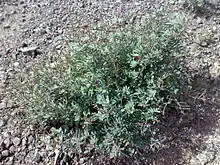 | |
| Scientific classification | |
| Kingdom: | Plantae |
| Clade: | Tracheophytes |
| Clade: | Angiosperms |
| Clade: | Eudicots |
| Clade: | Rosids |
| Order: | Fabales |
| Family: | Fabaceae |
| Subfamily: | Faboideae |
| Genus: | Tephrosia |
| Species: | T. apollinea |
| Binomial name | |
| Tephrosia apollinea | |
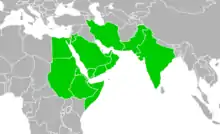 | |
| Distribution by country | |
| Synonyms[1] | |
| |
Tephrosia apollinea is a legume species, native to southwest Asia (the Levant, Arabian Peninsula, Socotra, Iran, Pakistan, northwestern India) and northeast Africa (Egypt, Sudan, Ethiopia, Eritrea, Djibouti, Somalia).[2][3][4]
The leaflets of the plant are obovate-oblong and equal-sided, and of a silky texture. The fruits (legumes) are typically 1 to 2 in (25 to 51 mm) long and contain six or seven brownish seeds. The species typically grows in areas where the soils are relatively deep, especially in semi-arid and wadi areas, and on terraces and slight inclines and hills.
Tephrosia apollinea is known to be toxic to goats. Although it has been used in Oman and the United Arab Emirates to treat bronchitis, cough, earache, nasal congestion and wounds and bone fractures,[5] as of 1993 its wider impact on humans had not been assessed. It can be used to make indigo-like dyes, and the leaves and those of other plants are used to make hot drinks by the Bedouin in parts of Sinai and the Negev.
Description
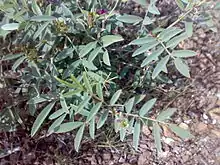
The plant's leaflets are obovate-oblong, somewhat wedge-shaped, equal-sided, and of a silky texture. The mid-rib is usually folded longitudinally,[6] and they are characterized by parallel transverse veins.[7] The fruits (legumes) are typically 1 to 2 in (25 to 51 mm) long and contain six or seven brownish seeds.[8][9][10] The plant displays purple flowers during season; they are described as their most attractive in January.[11] It typically grows to 45–50 cm (18–20 in) in height,[12] and can grow on mountains with an altitude of over 3,000 ft (910 m).[13] Both diploid (22 chromosomes) and tetraploid (44 chromosomes) cytotypes have been reported.[14]
The roots of Tephrosia apollinea are deep, penetrating soils to a depth of 3 metres or more, aiding the absorption of moisture from the soil.[12] Moisture is stored in the cortex of the roots, which is protected by a thin periderm. Water storage in the cortex enables growth and reproduction during times of drought. This allows it to thrive in both arid and semi-arid conditions and to survive during winter and summer months at times of low rainfall.[12] The roots grow at a faster rate than the shoots themselves, and even at the early stage of the plant displaying a shoot the length of a cm, the roots may already be 30 cm (12 in) or more in length.[12]
A proposed 1993 treatment of T. apollinea as a subspecies of Tephrosia purpurea noted some regional variations, with plants in the Eastern Desert of Egypt possibly producing smaller pods, leaves, and leaflets, and plants from oases having densely pubescent spreading hairs.[15] Among the features they described as differentiating the apollinea subspecies from the nominate purpurea subspecies were that apollinea has somewhat longer pods (3.5–5 or sometimes 5.5 cm, rather than 3–4 cm), a wider range in the quantity of seeds per pod (generally 7–9, as low as 3, rather than generally 5–6, or sometimes 7), the pods being curved upwards rather than downwards, and leaflets having 9 rather than 7 lateral veins.[15]
Taxonomy and names
The plant was initially named Galega apollinea by Alire Raffeneau Delile in 1813, and moved to the genus Tephrosia by Johann Heinrich Friedrich Link in 1822.[16][17]
Its treatment as a subspecies of Tephrosia purpurea, called Tephrosia purpurea subsp. apollinea, was proposed by Hasnaa A. Hosni and Zeinab A. R. El-Karemy in 1993.[15] This treatment has not been accepted by the databases The Plant List, International Legume Database & Information Service, or Tropicos.[1][4][18][19] Hosni and El-Karemy treated T. apollinea and T. purpurea as a single species after finding that their previous descriptions "agree in most of their characters and the distinction between typical forms is rather difficult..."[15] The full name with authorities under their revised classification is Tephrosia purpurea (L.) Pers. subsp. apollinea (Delile) Hosni & El-Karemy.[20]
In parts of southern Arabia, the species carries the vernacular name of hailara,[21] and it is also known as dhafra, dhawasi, omayye or nafal to Arabs,[22][23][24] and written as رﮭﻔط in the Arabic language.[25] In the Sinai area of Egypt, it is referred to by the Bedouin as sanna or senna.[26] It is also known as amioka in parts of Sudan.[27] Due to its traditional use in making indigo dyes, Tephrosia apollinea has also been referred to as "Egyptian indigo".[28]
Distribution and ecology
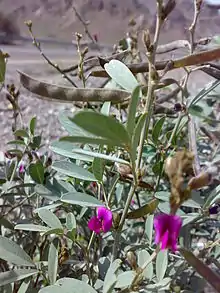
The species is recorded in the northeast African nations of Djibouti, Egypt, Eritrea, Ethiopia, Somalia, and Sudan, the Western Asian nations of Iran, Israel, Jordan, Oman, Saudi Arabia, South Yemen, the United Arab Emirates, and Yemen (including the Yemeni island of Socotra), and the South Asian nations of India and Pakistan.[3][4][29][30][31] Within India, it is documented in the western states of Gujarat, Maharashtra, and Rajasthan.[4]
The species, cited as a "leguminous desert forb",[32] typically grows in areas where the soils are relatively deep, especially in semi-arid[2] and wadi areas, and on terraces and slight inclines and hills.[32][33][34] In Saudi Arabia, it has been found scattered among species such as Zilla spinosa, Rhanterium epapposum, Astragalus spinosus, Gymnocarpos decandrum, Achillea fragrantissima and Halothamnus bottae on the edges of desiccated lakes.[35]
It has been well documented in sources in Egypt and Sudan.[8][36] In 1866, the Pharmaceutical Journal stated that it was found as a contaminant in Alexandrian senna, being found in cultivated fields in the valleys to the east and south of Assouan, in the Elephantine Islands, opposite Assouan, along the Nile, and Edfou and Hermonthis.[10] In Israel, it grows in the Judean desert, the Dead Sea Valley, the Negev hills, and Eilat.[29]
In wadi areas of Yemen, it tends to grow on desert alluvial shrubland and coexist with Fagonia indica, Cymbopogon schoenanthus, and Boerhavia elegans.[37] An example of Tephrosia apollinea was found by Harry St John Bridger Philby in 1936 at Raiyan, about 150 mi (240 km) northeast of Sana'a.[38] In Socotra, an island off the coast of Yemen, it is typically found in the Croton shrubland of lowland plains at altitudes of between sea level and 100 metres on overgrazed soils, along with Cassia holsericea.[39] In a 2000s analysis of vegetation in the woodlands of northern Socotra, the species was found to coexist with Achyranthus aspera, Ageratum conyzoides, Bidens chinensis, Forsskaolea viridis, Hibiscus vitifolius, Indigofera coerulea, Leucas urticifolia, Setaria adhaerens and Solanum incanum.[40]
Tephrosia apollinea is also found in the United Arab Emirates and in Oman,[11][41] where it inhabits the Jiddat al-Harasis desert and dominates the beds of wadis in mountains such as Jebel Shams.[42]
Toxicity
Tephrosia apollinea is cited as "unpalatable",[43] although the seeds of the plant are reportedly a favourite of sandgrouse inhabiting the scrub-desert of northern Sudan,[27][44] and the butterfly Colias croceus is known to feed on it.[45] This has allowed it to colonize the landscape in parts of the Middle East which have been overgrazed, especially at lower altitudes.[46]
The species is known to be toxic to goats; a study published in the early 1980s revealed that 11 out of 12 goats died after 1 to 40 days of daily oral dosing of Tephrosia apollinea shoots (fresh or dried), and that they displayed adverse reactions to ingesting it such as dyspnoea, weakness of the limbs and joints causing instability in movement, changes in fat composition, catarrhal enteritis, and hemorrhage in the heart, lungs, and intestinal mucosa.[47] Rotenoids extracted from the seeds of the plant also caused complete mortality in Aphis craccivora, when applied at a concentration of 0.1% for 48 hours.[48]
Uses
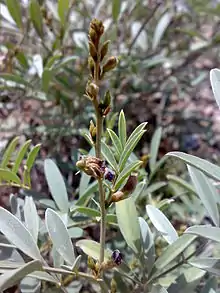
Tephrosia apollinea can be used to make indigo dyes.[36][49] The species was noted to be commonly cultivated for this purpose in Nubia in the 1800s.[9]
The plant is used traditional medicinal and has some anti-bacterial properties; the leaves and the root have been used used in traditional medicinal on bronchitis, cough, earache, wounds and bone fractures by herbalists in countries such as Oman and the United Arab Emirates.[5][50] The ground leaves of Tephrosia apollinea are also insufflated in cases of nasal congestion, or boiled with water to make eardrops.[50] Powdered bark can be mixed with water and poured into the ears of camels with ticks, and powdered leaves have been made into a paste to be smeared on wounds.[24] It has also been rubbed on limbs in conjunction with Fagonia indica and Ocomim basilicum of people affected with polio, without any effect.[51]
Although unpalatable when consumed raw, when boiled the leaves of Tephrosia apollinea and numerous other plants are used to make hot drinks by the Bedouin in parts of Sinai and the Negev.[26] But herbalists in Oman warn that Tephrosia apollinea can be potentially harmful to humans, and as of 1993, it had not been fully analyzed chemically to assess the wider impact it could have on health.[50]
Phytochemistry
When dried, the leaves of Tephrosia apollinea were found to contain 4.4% moisture, 21.1% of crude protein, 19.8% of crude fiber, and 10.9% of ash.[52] A chemical analysis found that it contains rotenoids, isolflavones, flavanones, chalcones, and flavones,[53] The chloroform extract of the aerial part of Tephrosia apollinea also revealed seven new 8-prenylated flavonoids, including tephroapollin A-G (1-7).[54]
In 2006, researchers of Oman's Sultan Qaboos University published their findings from a chemical investigation into the leaves in which they found it contained semiglabrin, semigalbrinol, and a new flavanone named apollineanin.[55] One 2014 study revealed that pseudosemiglabrin extracted from the aerial parts of Tephrosia apollinea had an antiproliferative effect on cancer cell lines.[53]
A study of Tephrosia apollinea from the Wadi Ejili, in Ras Al Khaimah, UAE, focusing on seeds collected from specimens of the traditional medicinal plant explored its exogenous production of silver nanoparticles. The study is thought to be the first time the antimicrobial activity of silver nanoparticles synthesized via living plants has been observed.[5]
References
- 1 2 "Tephrosia apollinea (Delile) DC". The Plant List. 2013. Retrieved 2014-04-04.
- 1 2 Bhardwaj, N (1985). "Effect of temperature and photoperiod on growth and reproduction of Tephrosia species". Japanese Journal of Ecology (Nihon Seitai Gakkaishi). The Ecological Society of Japan. 35 (2): 193–197. ISSN 0021-5007.
The paper describes the results of a field and an experimental study of the effects of temperature and photoperiod on the growth and flowering of Tephrosia apollinea and T. hamiltonii which are common perennial weeds in the semiarid areas of Rajasthan.
- 1 2 "Tephrosia apollinea". Flora of Pakistan, eFloras.org. Missouri Botanical Garden. Retrieved 2014-04-09.
- 1 2 3 4 "Tephrosia apollinea". ILDIS LegumeWeb. International Legume Database & Information Service. Retrieved 2014-04-11.
- 1 2 3 Ali, Muna; Mosa, Kareem; El-Keblawy, Ali; Alawadhi, Hussain (1 December 2019). "Exogenous Production of Silver Nanoparticles by Tephrosia apollinea Living Plants under Drought Stress and Their Antimicrobial Activities". Nanomaterials. 9 (12): 1716. doi:10.3390/nano9121716. ISSN 2079-4991. PMC 6955765. PMID 31805737.
- ↑ "Senna". Botanical.com. Retrieved 2014-04-13.
- ↑ Garrod, Sir Alfred Baring (1868). The Essentials of Materia Medica, Therapeutics, and the Pharmacopoeias. p. 214.
- 1 2 Pereira, Jonathan (8 April 1837). "Lectures on materia medica, or pharmacology, and general therapeutics, delivered at the Aldersgate School of Medicine". The London Medical Gazette. London: Longman, Orme, Brown, Green, and Longmans. 20: 36.
- 1 2 Lindley, John (1838). Flora Medica, a Botanical Account of All the More Important Plants Used in Medicine, in Different Parts of the World. London: Longman, Orme, Brown, Green, and Longmans. pp. 244, 259.
- 1 2 "Reviews: Manual of Materia Medica and Therapeutics". Pharmaceutical Journal and Transactions. 2nd series. John Churchill & Sons. 7 (6): 341. 1865.
- 1 2 Mostyn, Trevor (1 January 1982). UAE: A MEED Practical Guide. Middle East Economic Digest. p. 37. ISBN 978-0-7103-0014-0.
- 1 2 3 4 Bhardwaj, Nagendra; Gopal, Brij (1979). "Study of the Root System of Tephrosia apollinea and its survival value under arid conditions". Japanese Journal of Ecology. 29 (3): 229–234. ISSN 0021-5007. Retrieved 2023-10-17.
- ↑ Lugard, E.; Brown, N. E. (1909). "The flora of Ngamiland". Bulletin of Miscellaneous Information. Royal Gardens, Kew. 1909 (3): 81–146 (see p. 103). doi:10.2307/4111525. ISSN 0366-4457. JSTOR 4111525. Note: some page numbers in the biodiversitylibrary.org scan are misordered.
- ↑ Jahan, Bushreen; Vahidy, Ahsan A.; Ali, S.I. (1994). "Chromosome numbers in some tax of Fabaceae mostly native to Pakistan". Annals of the Missouri Botanical Garden. 81 (4): 792–795. doi:10.2307/2399924. JSTOR 2399924.
- 1 2 3 4 Hosni, H. A.; El-Karemy, Z. A. R. (1993). "Systematic revision of Leguminosae in Egypt. 1. Tephrosia Pers". Sendtnera. 1: 245–257. ISSN 0944-0178.
- ↑ Link, Johann Heinrich Friedrich (1822). Enumeratio plantarum Horti regii botanici berolinensis altera (in Latin). Vol. 2. Apud G. Reimer. p. 252.
- ↑ Delile, Alire Raffeneau (1813). "Flore d'Égypte, explications des planches: Description de l'Égypte, ou, Recueil des observations et des recherches qui ont été faites en Égypte pendant l'expédition de l'armée française". Histoire Naturelle (in French). Vol. 2. De l'Imprimerie Impériale. p. 288.
- ↑ "Search results". The Plant list. 2013. Retrieved 2014-04-15.
- ↑ "Tephrosia purpurea". Missouri Botanical Garden. Retrieved 2014-04-15.
- ↑ Abd El-Ghani, Monier M.; Abdel-Khalik, Kadry N. (2006). "Floristic diversity and phytogeography of the Gebel Elba National Park, south-east Egypt" (PDF). Turkish Journal of Botany. 30 (2): 121–136.
- ↑ Thesiger, Wilfred (1946). "A new journey in southern Arabia". The Geographical Journal. The Royal Geographical Society. 108 (4/6): 129–145. doi:10.2307/1789822. ISSN 0016-7398. JSTOR 1789822. See page 132.
- ↑ "Dhafra (Tephrosia apollinea)". Arkive.org. Archived from the original on 2014-04-13. Retrieved 2014-04-09.
- ↑ "Common names and scientific names of feeds" (PDF). National Institute of Animal Nutrition and Physiology. Retrieved 2014-04-13.
- 1 2 "Characterisation of the Wurayah Catchment Basin. the First Mountain Protected Area in the United Arab Emirates" (PDF). International Journal of Ecology and Environmental Sciences. 35 (4): 289–311 (p. 8 in PDF). 2009. Retrieved 2014-04-13.
- ↑ "Information Sheet on Ramsar Wetlands (RIS) 2009-2014 version" (PDF). Ramsar. Archived from the original (PDF) on 2014-04-14. Retrieved 2014-04-13.
- 1 2 Bailey, Clinton; Danin, Avinoam (1981). "Bedouin plant utilization in Sinai and the Negev". Economic Botany. New York Botanical Garden Press on behalf of The Society for Economic Botany. 35 (2): 145–162. doi:10.1007/bf02858682. ISSN 1874-9364. JSTOR 4254272. S2CID 27839209. See pages 151, 161.
- 1 2 Jackson, H. C. (1926). "A trek in Abu Hamed district". Sudan Notes and Records. University of Khartoum. 9 (2): 1–35. JSTOR 41715481. See page 6.
- ↑ "Indigo". Digital Library of India. Archived from the original on 2014-04-14. Retrieved 2014-04-13.
- 1 2 "Tephrosia apollinea". Wild Flowers of Israel. Retrieved 2014-04-09.
- ↑ Albert, Roland; Petutschnig, Bibiane; Watzka, Margarete (2004). "Zur Vegetation und Flora Jordaniens" (PDF). Denisia. Landesmuseen Neue Serie 2 (in German). 14: 133–220.
- ↑ Musselman, Lytton John (27 April 2007). "Checklist of Plants of the Hashemite Kingdom of Jordan". Plant Site. Old Dominion University. Retrieved 2014-04-11.
- 1 2 Schiffman, Yale M.; Society, U.S. Region Remote Sensing (1984). Proceedings of a Working Group Meeting, August 22–26, 1983, San Francisco, California: Earth resource management, an international perspective. CERMA. p. 44.
- ↑ Zahran, M. A. (10 March 2010). Climate – Vegetation:: Afro-Asian Mediterranean and Red Sea Coastal Lands. Springer. p. 184. ISBN 978-90-481-8595-5.
- ↑ Sharma, K. P.; Upadhyaya, B. P. (2002). "Phytosociology, primary production and nutrient retention in herbaceous vegetation of the forestry arboretum on the Aravalli hills at Jaipur" (PDF). Tropical Ecology. 43 (2): 325–335. See page 329.
- ↑ Al-Ghanem, Wafaa Mohammed (September 2011). "Ecological study on Uyun Layla in Saudi Arabia". African Journal of Environmental Science and Technology. 5 (9): 668–672. ISSN 1996-0786. Retrieved 2014-04-13.
- 1 2 Knox, Alexander; Knox, Mary S. (1911). "Appendix I: Explanatory glossary of the principal vegetable productions except timber-trees". The Climate of the Continent of Africa. University of Cambridge. p. 513.
- ↑ Abdul Wali Ahmed Al Khulaidi (September 2006). Environmental and human determinates of vegetation distribution in the Hadhramaut region, Republic of Yemen (PhD thesis). Edinburgh Research Archive. hdl:1842/1953. Retrieved 2014-04-13.
- ↑ Scott, Hugh (4 July 2013). In The High Yemen. Kegan Paul Arabia Library. Routledge. p. 238. ISBN 978-1-136-18766-7.
- ↑ "Socotra Archipelago Yemen" (PDF). United Nations Environment Programme and the World Conservation Monitoring Centre, accessed via the Socotra Governance & Biodiversity Project. Retrieved 2014-04-13.
- ↑ Kürschner, Harald; Hein, Peter; Kilian, Norbert; Hubaishan, Mohammed A. (2006). "Diversity and zonation of the forests and woodlands of the mountains of Northern Socotra, Yemen". Englera (28: Biodiversity of Socotra Forests, Woodlands and Bryophyte): 11–55. doi:10.2307/20358182. ISSN 0170-4818. JSTOR 20358182.
- ↑ Barth, H.-J.; Böer, Benno (31 March 2002). Sabkha Ecosystems: Volume I: The Arabian Peninsula and Adjacent Countries. Springer. p. 105. ISBN 978-1-4020-0504-6.
- ↑ Ghazanfar, Shahina A. (1991). "Vegetation structure and phytogeography of Jabal Shams, an arid mountain in Oman". Journal of Biogeography. Wiley. 18 (3): 299–309. doi:10.2307/2845400. ISSN 0305-0270. JSTOR 2845400.
- ↑ Ghazanfar, S.A.; Fisher, M. (31 August 1998). Vegetation of the Arabian Peninsula. Springer. p. 188. ISBN 978-0-7923-5015-6.
- ↑ Bowen, W. Wedgwood (1928). "The game-birds and water-fowl of the Sudan". Sudan Notes and Records. University of Khartoum. 11: 69–82. JSTOR 41715949. See page 71.
- ↑ Nota Lepidopterologica. The butterflies of the Sinai Peninsula (Lep. Rhopalocera). Vol. 7. Biodiversity Heritage Library. 1984. Retrieved 2014-03-13.
- ↑ Brown, Gary; Mies, Bruno A. (22 May 2012). Vegetation Ecology of Socotra. Springer. p. 82. ISBN 978-94-007-4141-6.
- ↑ Suliman, Hagir B.; Wasfi, I.A.; Adam, S.E.I. (1982). "The toxic effects of Tephrosia apollinea on goats". Journal of Comparative Pathology. Elsevier. 92 (2): 309–15. doi:10.1016/0021-9975(82)90090-1. ISSN 0021-9975. PMID 7085947.
- ↑ Salem, I. E. M.; Abdel-Hafez, M. M. "Natural rotenoids from Tephrosia apollinea and their effects against Aphis craccivora Koch (Aphididae)". Mededelingen van de Faculteit Landbouwwetenschappen, Rijksuniversiteit Gent 1990 Vol. 55 No. 2b pp. 657-660. Retrieved 2014-04-13.
- ↑ Lindley, John (1836). A Natural System of Botany: Or a Systematic View of the Organisation Natural Affinities and Geographical Distribution of the Whole Vegetal Kingdom ... (2nd ed.). Longman, Rees, Orme, Brown, Green, and Longmans. p. 153.
- 1 2 3 Ghazanfar, Shahina A.; Al-Sabahi, Ahmed Mohammed Ali (1993). "Medicinal plants of northern and central Oman (Arabia)". Economic Botany. New York Botanical Garden Press on behalf of The Society for Economic Botany. 47 (1): 89–98. doi:10.1007/bf02862209. ISSN 1874-9364. JSTOR 4255485. S2CID 45450754.
- ↑ Ghazanfar, Shahina A. (24 August 1994). Handbook of Arabian Medicinal Plants. CRC Press. p. 216. ISBN 978-0-8493-0539-9.
- ↑ Dirar, Hamid A. (1984). "Kawal, meat substitute from fermented Cassia obtusifolia leaves". Economic Botany. New York Botanical Garden Press on behalf of The Society for Economic Botany. 38 (3): 342–349. doi:10.1007/bf02859013. ISSN 1874-9364. JSTOR 4254649. S2CID 32446384.
- 1 2 Ahmed Hassan, Loiy Elsir; Khadeer Ahamed, Mohamed B.; Abdul Majid, Aman Shah; Iqbal, Muhammad Adnan; Al Suede, Fouad Saleih R.; Haque, Rosenani A.; Ismail, Zhari; Ein, Oon Chern; Majid, Amin Malik Shah Abdul (2014). Kyprianou, Natasha (ed.). "Crystal structure elucidation and anticancer studies of (-)-pseudosemiglabrin: A flavanone isolated from the aerial parts of Tephrosia apollinea". PLOS ONE. Public Library of Science. 9 (3): e90806. Bibcode:2014PLoSO...990806A. doi:10.1371/journal.pone.0090806. ISSN 1932-6203. PMC 3946547. PMID 24608571.
- ↑ El-Razek, Mohamed H. Abd; Abou El-Hamd, Mohamed H.; Ahmed, Ahmed A. "Prenylated flavonoids, from Tephrosia apollinea". Faculty of Science, Minia University. Archived from the original on 2014-04-13. Retrieved 2014-04-13.
- ↑ Hisham, A.; John, Shaly; Al-Shuaily, Wafa; Asai, Teigo; Fujimoto, Yoshinori (2006). "(+)-Apollineanin: A new flavanone from Tephrosia apollinea". Natural Product Research. Taylor & Francis. 20 (12): 1046–52. doi:10.1080/14786410500399714. ISSN 1478-6419. PMID 17127656. S2CID 7205518.